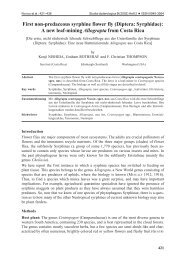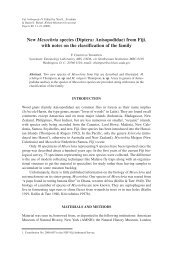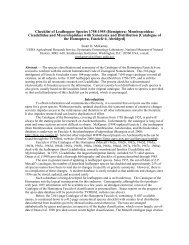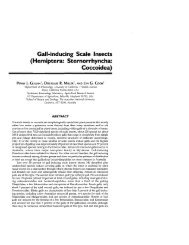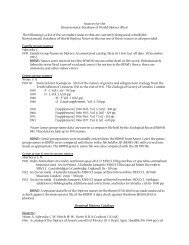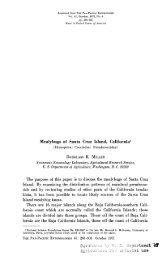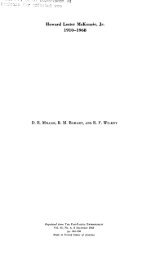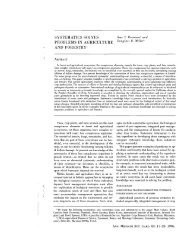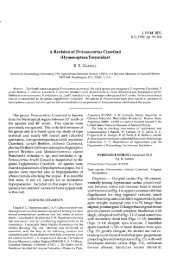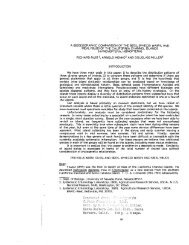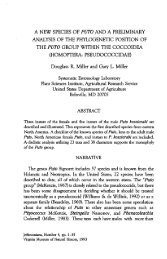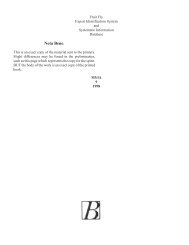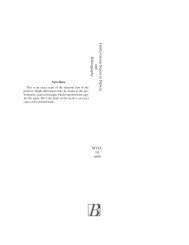Systematic revision of the Family Micrococcidae (Homoptera ...
Systematic revision of the Family Micrococcidae (Homoptera ...
Systematic revision of the Family Micrococcidae (Homoptera ...
You also want an ePaper? Increase the reach of your titles
YUMPU automatically turns print PDFs into web optimized ePapers that Google loves.
- 236 <br />
pores associated with anterior spiracle. Parastigmatic pores <strong>of</strong> multilocular<br />
type, with 6-15 loculi, with or without central loculus, 40 (24-59) pores on each<br />
side <strong>of</strong> body, restricted to areas around spiracular plates, occasionally near<br />
base <strong>of</strong> antennae.<br />
Legs with hind femora each with 10 (8-11) setae; tibia with 5 (3-7) setae; tarsus<br />
with 4 (2-6) setae; tarsus without modified digitules; claw digitules with inconspicuous,<br />
clubbed apices, not reaching apex <strong>of</strong> claw; femur 221 (207-237) 1.1..<br />
long; tibia 194 (178-210) 1.1.. long; tarsus 89 (71-101) 1.1.. long; femur length divided<br />
by tibia +tarsus length 0.8. Antennae 3-segmented, 174 (153-183) 1.1.. long; segment<br />
III 83 (77-96) 1.1.. long, with 12 (10-13) setae; segment II 40 (30-49) 1.1.. long,<br />
53 (49-59) 1.1.. wide.<br />
Notes - This description is based on 21 specimens from 2 localities.<br />
This species is quite unusual since it folds itself around <strong>the</strong> rootlets <strong>of</strong> <strong>the</strong><br />
host and appears like a bivalve mollusc. A deep groove is formed inside <strong>of</strong> <strong>the</strong><br />
macrotubular duct band. It also is interesting that <strong>the</strong>re are 2 distinct types <strong>of</strong><br />
females, 1 with very long dorsal setae (all collected in Marendellas), and <strong>the</strong><br />
o<strong>the</strong>r with short dorsal setae occurring both in Marendellas and Inkomo. We<br />
could fmd no o<strong>the</strong>r evidence to suggest that <strong>the</strong>se differences characterize two<br />
different species.<br />
First instar (Sex not determined) (Fig. XV)<br />
Recognition characters: Mounted, 0.7 (0.7-0.8) mm long, 0.3 (0.3-0.4) mm<br />
wide.<br />
Dorsum with filamentous setae arranged in 2 longitudinal rows on each side<br />
<strong>of</strong> body, submedial line restricted to segment I, thorax, and head, marginal line<br />
present around perimeter <strong>of</strong> body, except on segments IV-VIII; longest seta on<br />
dorsomedial area <strong>of</strong> metathorax 11 (10-12) 1.1.. long, all setae in area about same<br />
length. Marginal setae usually about same length as rest <strong>of</strong> dorsum. Discoidal<br />
pores arranged in 1 longitudinal line on each side <strong>of</strong> body.<br />
Anal lobes (plates) each with 3 (3 or 4) setae; longest seta 224 (190-247) 1.1..<br />
long. Anal ring with 3 setae and 7 (6-9) pores on each half.<br />
Venter with small setae arranged in segmental rows, longest seta on abdomen,<br />
excluding marginal ones, 32 (23-40) 1.1.. long. Microtubular ducts present<br />
in 1 submarginal line on each side <strong>of</strong> body, with 1 duct present on each segment.<br />
Macrotubular ducts present around perimeter <strong>of</strong> body, with 3 ducts on<br />
each lateral margin <strong>of</strong> each abdominal segment. Discoidal pores absent. Intrastigmatic<br />
pores absent. With 1 parastigmatic pore near each spiracle, absent<br />
elsewhere, without central loculi, with 5 loculi.<br />
Legs with hind femora each with 3 setae; tibiae with 3; tarsi with 4; tarsal



